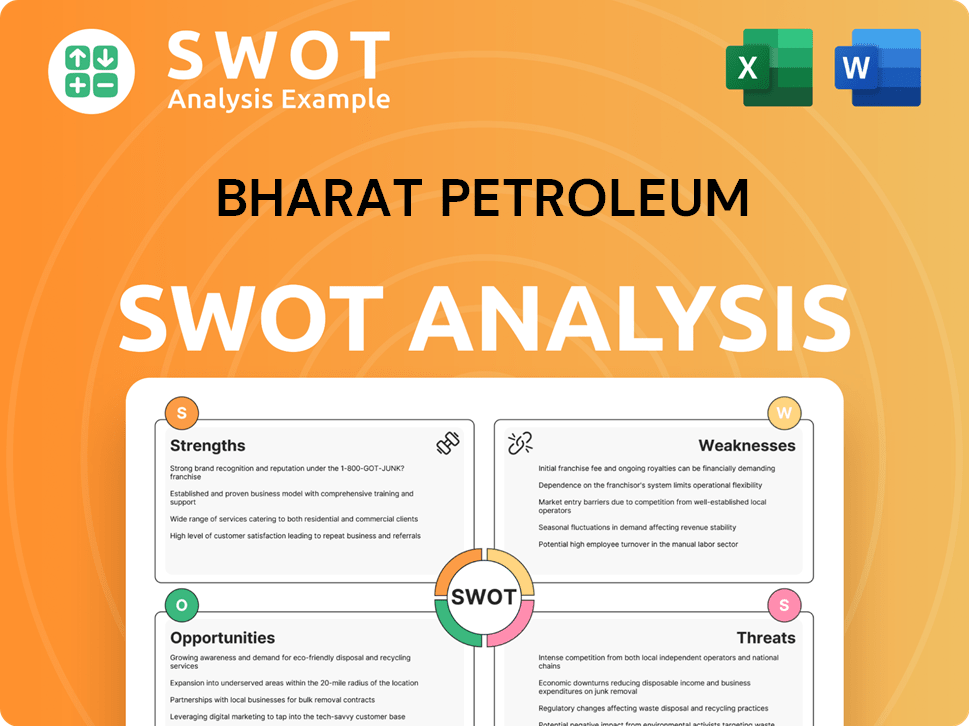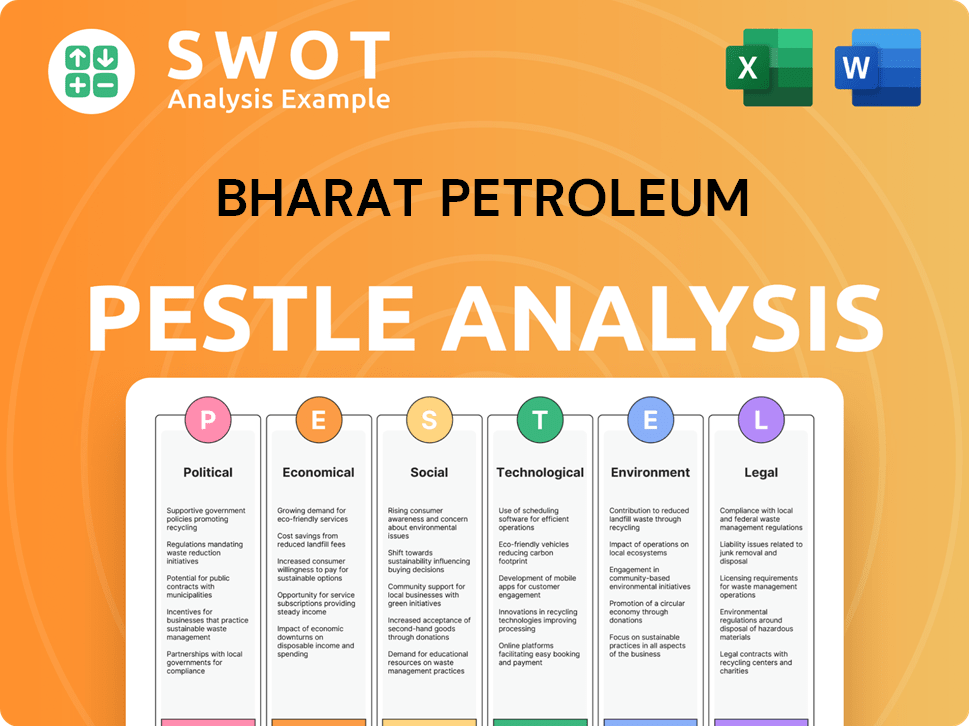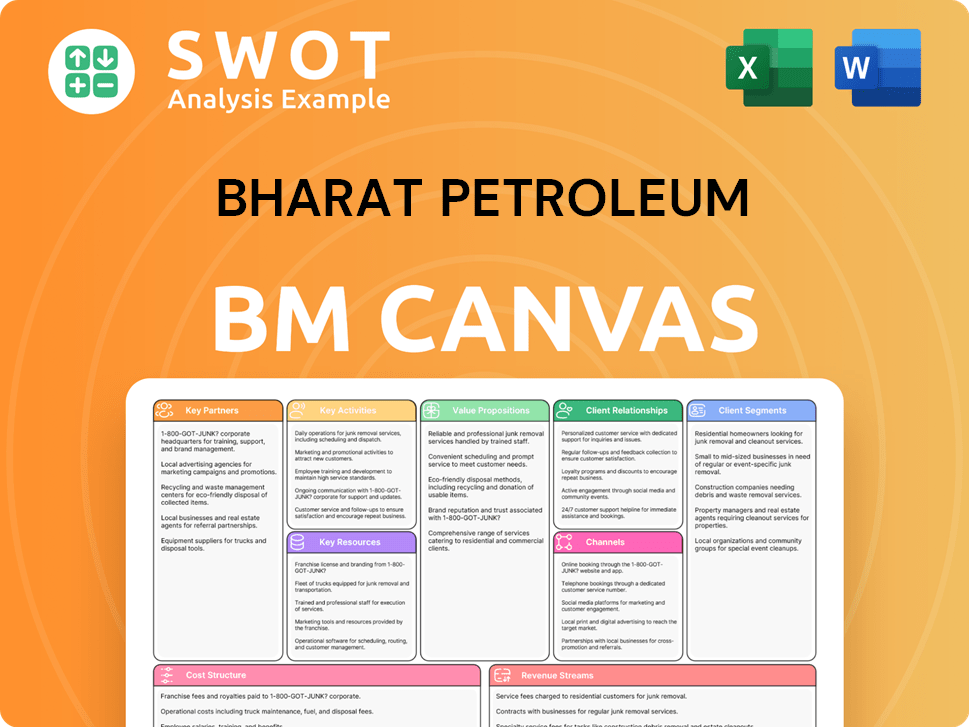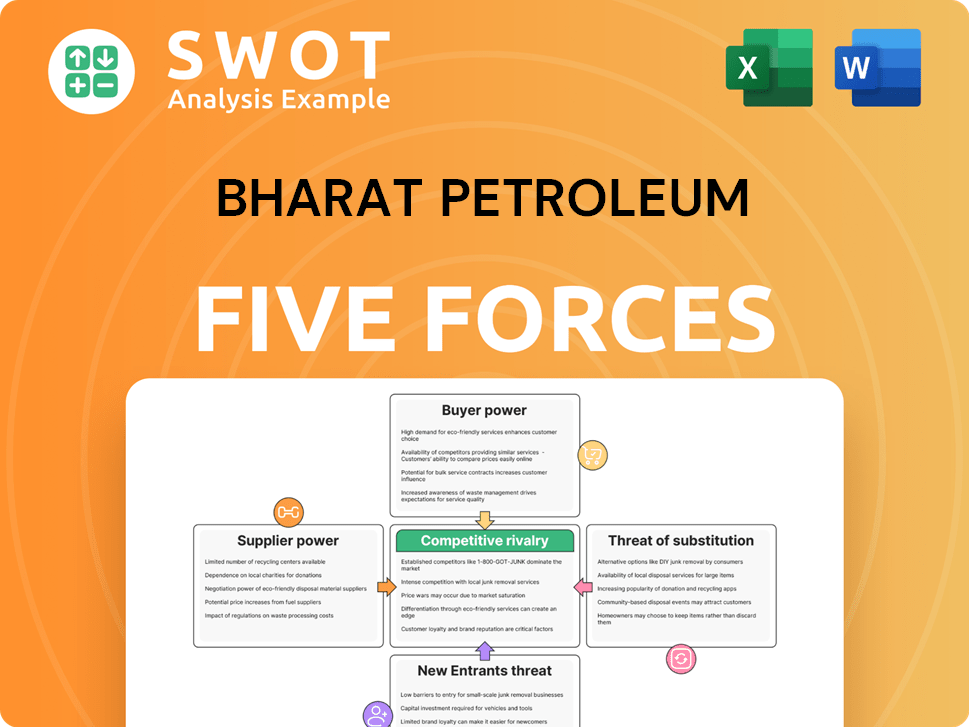Bharat Petroleum Bundle
How did Bharat Petroleum Rise to Become an Energy Giant?
Journey back in time to discover the fascinating Bharat Petroleum SWOT Analysis and the rich history of BPCL, a cornerstone of India's energy landscape. From its British roots in 1928 as Burmah Shell to its current status as a Fortune Global 500 company, BPCL's evolution mirrors India's own transformation. Uncover the pivotal moments and strategic decisions that shaped this Indian Oil Company into a leading player in the Petroleum Industry.

The brief history of Bharat Petroleum Company, or BPCL, showcases a remarkable transformation within the Oil and Gas sector. Beginning as a foreign entity, BPCL navigated nationalization and market liberalization to become a key driver in India's economic growth. Exploring the early days of Bharat Petroleum provides crucial context for understanding its current market share and future outlook, solidifying its significance in the Indian petroleum market.
What is the Bharat Petroleum Founding Story?
The story of Bharat Petroleum (BPCL) begins in 1928, with the establishment of the Burmah Shell Oil Storage & Distribution Company of India. This early venture was a collaborative effort, marking the beginning of a significant presence in the Indian petroleum market. The initial focus was on importing and distributing oil products across India, a strategy that laid the groundwork for future growth.
In 1952, the company took a major step forward by establishing Burmah Shell Refineries, leading to the incorporation of Burmahshell Refineries Limited (BSR) on November 3, 1952. This move was crucial for local refining capabilities. The refinery in Mumbai commenced operations in 1955, ahead of schedule, and introduced innovations like LPG as a cooking fuel.
The most pivotal moment arrived on January 24, 1976, when the Indian government nationalized Burmah Shell's operations. This led to the formation of Bharat Refineries Limited on February 12, 1976, which was later renamed Bharat Petroleum Corporation Limited (BPCL) on August 1, 1977. This marked the transition to a public sector undertaking, with the government acquiring full equity. BPCL's refining capacity and market share have grown significantly since then.
The early days of Bharat Petroleum were marked by strategic imports and distribution networks.
- The company's roots trace back to 1928, when the Burmah Shell Oil Storage & Distribution Company of India was established.
- Initial operations involved importing oil products and distributing them across India.
- The introduction of LPG as a cooking fuel in the mid-1950s was a significant innovation.
- Nationalization in 1976 transformed the company into a public sector undertaking.
Bharat Petroleum SWOT Analysis
- Complete SWOT Breakdown
- Fully Customizable
- Editable in Excel & Word
- Professional Formatting
- Investor-Ready Format

What Drove the Early Growth of Bharat Petroleum?
Following its nationalization in 1976 and rebranding in 1977, Bharat Petroleum (BPCL) experienced significant growth, aligning with India's evolving energy needs. The company focused on strengthening its core business of refining crude oil and marketing petroleum products. This strategic focus helped establish BPCL as a key player in the Indian Oil Company and the broader Petroleum Industry.
In the early 1990s, BPCL began offering shares to the public, a step towards privatization. During the fiscal year 2001-02, BPCL invested in projects like the Gas Turbine and Heat Recovery Steam Generator, costing Rs. 1,750 million. Simultaneously, a Refinery Modernization Project was undertaken to enhance efficiency, costing Rs. 18,310 million.
BPCL diversified its revenue streams by establishing an Allied Retail Business (ARB), becoming a leading non-fuel revenue generator. This included convenience stores, quick service restaurants, and financial services. The company expanded its retail network, commissioning 50 retail outlets, including 9 in rural areas, and 7 superior kerosene oil/light diesel oil dealerships in 1992.
In 2022-23, BPCL strategically merged with Bharat Oman Refineries Limited. As of FY25, BPCL achieved its highest-ever throughput of 40.51 MMT and market sales of 52.40 MMT, representing a sales growth of 2.66% compared to FY23-24. The company's total income for the financial year ended March 31, 2025, was ₹5,03,202.20 crores.
BPCL significantly expanded its retail and EV infrastructure in FY 2024-25, commissioning 1,805 new retail outlets and expanding its EV charging network to 6,563 stations. The company's distribution network now comprises over 22,000 fuel stations, over 6,250 LPG distributorships, 525 Lubes distributorships, 123 POL storage locations, 54 LPG Bottling Plants, 63 Aviation Service Stations, 5 Lube blending plants, and 4 cross-country pipelines as of August 31, 2024. For more insights into the company's revenue streams, check out this article on Revenue Streams & Business Model of Bharat Petroleum.
Bharat Petroleum PESTLE Analysis
- Covers All 6 PESTLE Categories
- No Research Needed – Save Hours of Work
- Built by Experts, Trusted by Consultants
- Instant Download, Ready to Use
- 100% Editable, Fully Customizable

What are the key Milestones in Bharat Petroleum history?
The History of BPCL is marked by significant achievements in the Indian Oil Company and Petroleum Industry. From its early days, Bharat Petroleum has grown, adapting to the evolving Oil and Gas sector and contributing significantly to India's economy.
| Year | Milestone |
|---|---|
| Mid-1950s | Introduction of LPG as a cooking fuel in Indian homes, a pioneering move in the Petroleum Industry. |
| July 2001 | Establishment of the Corporate Research & Development Centre (CRDC), a hub for innovation. |
| 2005 | Development of Bharat Metal Cutting Gas (BMCG), enhancing operational efficiency. |
| 2017 | Awarded 'Maharatna' status by the Government of India, recognizing its operational and financial autonomy. |
BPCL's Corporate Research & Development Centre (CRDC) has been a key driver of innovation, filing 164 patents as of May 2023. These innovations have led to the commercialization of 17 technologies and products, enhancing profitability and reducing environmental impact.
Developed in 2005, this innovation improved operational efficiency in industrial applications. The History of BPCL includes several technological advancements.
This catalyst was developed to reduce sulfur content in gasoline, contributing to cleaner fuel. This is a key aspect of Bharat Petroleum's commitment to environmental sustainability.
Bharat Ecochem was designed to mitigate corrosion issues in ethanol-blended fuels. This innovation supports the use of biofuels.
Bharat Hi-CAT is an indigenous catalyst used in the dewaxing process, enhancing fuel quality. This development showcases BPCL's technological capabilities.
BPMARRK is an intelligent tool for rapid crude oil assaying, reducing the time from weeks to just an hour. This tool significantly improves operational efficiency.
BPCL developed the K Model for crude oil compatibility, making it the only company globally to achieve this. This innovation enhances the company's refining capabilities.
BPCL faced challenges in FY 2024-25, with standalone net profit declining to ₹13,275.26 crore. The company's average gross refining margin (GRM) dropped to $6.82 per barrel in FY 2024-25, from $14.14 per barrel in FY 2023-24.
The company's financial performance in FY 2024-25 saw a standalone net profit decline. This was influenced by lower refining margins and an exceptional loss.
BPCL is focusing on digital transformation and expanding its non-fuel retail business. These strategic shifts demonstrate BPCL's commitment to overcoming obstacles.
BPCL has a comprehensive roadmap to achieve net-zero emissions for Scope 1 and Scope 2 by 2040. This involves investments in renewable power and other sustainable solutions.
The dynamic nature of the energy sector poses ongoing challenges. BPCL adapts by investing in sustainable solutions and diversifying its portfolio.
The company is responding to market pressures through strategic pivots. These include focusing on digital transformation and expanding non-fuel retail.
BPCL is investing in renewable power, green hydrogen, and other sustainable solutions. These investments are crucial for long-term growth and sustainability.
Bharat Petroleum Business Model Canvas
- Complete 9-Block Business Model Canvas
- Effortlessly Communicate Your Business Strategy
- Investor-Ready BMC Format
- 100% Editable and Customizable
- Clear and Structured Layout

What is the Timeline of Key Events for Bharat Petroleum?
The History of BPCL, or Bharat Petroleum, is marked by significant milestones, from its inception as Burmah Shell to its current status as a major player in the Indian petroleum industry. The company's journey reflects the evolution of India's oil and gas sector and its strategic adaptations to meet the growing energy demands of the nation.
| Year | Key Event |
|---|---|
| 1928 | Burmah Shell Oil Storage & Distribution Company of India was incorporated in England. |
| 1952 | Burmahshell Refineries Limited (BSR) was incorporated to set up a refinery in Mumbai. |
| 1955 | The refinery at Mahul, Chembur (Mumbai) was commissioned, and LPG was introduced as cooking fuel. |
| 1976 | Burmah Shell operations were nationalized by the Government of India, forming Bharat Refineries Limited. |
| 1977 | The company was renamed Bharat Petroleum Corporation Limited (BPCL). |
| 1992 | The government initiated steps towards privatizing BPCL by offering shares to the public. |
| 2001 | The Corporate Research & Development Centre (CRDC) was established. |
| 2005 | The first major R&D breakthrough with Bharat Metal Cutting Gas (BMCG) occurred. |
| 2017 | BPCL was awarded 'Maharatna' status. |
| June 2024 | BPCL issued bonus shares in a 1:1 ratio. |
| FY 2024-25 | Achieved highest-ever throughput of 40.51 MMT and market sales of 52.40 MMT. |
| April 29, 2025 | The Board recommended a final dividend of ₹5 per equity share for FY 2024-25. |
BPCL has an ambitious capital expenditure plan of approximately ₹1.70 lakh crore over the next five years. About ₹1 lakh crore of this is earmarked for green energy initiatives, showcasing a strong commitment to sustainability. This investment is a key part of its 'Project Aspire' strategy.
BPCL aims to build 2 GW of renewable energy capacity by 2025 and expand to 10 GW by 2035. This includes investments in captive wind power plants in Maharashtra and Madhya Pradesh (₹1,000 crore) and a solar project in Uttar Pradesh (₹300 crore). The company is also working on green hydrogen projects.
Analysts forecast BPCL to grow earnings and revenue by 6.5% and 1.4% per annum, respectively. The EPS is expected to grow by 8.2% annually. The company's focus on sustainable solutions and strengthening its LNG sourcing portfolio are aligned with its vision.
BPCL plans to set up 3.2 MMTPA petrochemical capacity by FY29, targeting an 8% share of petrochemicals in its product portfolio by FY29. The company is also exploring a greenfield refinery project in Andhra Pradesh and anticipates the potential restart of its Mozambique project by July 2025.
Bharat Petroleum Porter's Five Forces Analysis
- Covers All 5 Competitive Forces in Detail
- Structured for Consultants, Students, and Founders
- 100% Editable in Microsoft Word & Excel
- Instant Digital Download – Use Immediately
- Compatible with Mac & PC – Fully Unlocked

Related Blogs
- What is Competitive Landscape of Bharat Petroleum Company?
- What is Growth Strategy and Future Prospects of Bharat Petroleum Company?
- How Does Bharat Petroleum Company Work?
- What is Sales and Marketing Strategy of Bharat Petroleum Company?
- What is Brief History of Bharat Petroleum Company?
- Who Owns Bharat Petroleum Company?
- What is Customer Demographics and Target Market of Bharat Petroleum Company?
Disclaimer
All information, articles, and product details provided on this website are for general informational and educational purposes only. We do not claim any ownership over, nor do we intend to infringe upon, any trademarks, copyrights, logos, brand names, or other intellectual property mentioned or depicted on this site. Such intellectual property remains the property of its respective owners, and any references here are made solely for identification or informational purposes, without implying any affiliation, endorsement, or partnership.
We make no representations or warranties, express or implied, regarding the accuracy, completeness, or suitability of any content or products presented. Nothing on this website should be construed as legal, tax, investment, financial, medical, or other professional advice. In addition, no part of this site—including articles or product references—constitutes a solicitation, recommendation, endorsement, advertisement, or offer to buy or sell any securities, franchises, or other financial instruments, particularly in jurisdictions where such activity would be unlawful.
All content is of a general nature and may not address the specific circumstances of any individual or entity. It is not a substitute for professional advice or services. Any actions you take based on the information provided here are strictly at your own risk. You accept full responsibility for any decisions or outcomes arising from your use of this website and agree to release us from any liability in connection with your use of, or reliance upon, the content or products found herein.